Psychology Assignment: Stereotyping, Prejudice, Discrimination
VerifiedAdded on 2022/12/23
|6
|1376
|72
Homework Assignment
AI Summary
This psychology assignment delves into the concepts of stereotyping, prejudice, and discrimination. Task 1 focuses on understanding how central traits, primacy/recency effects, and cognitive functions influence attitude formation. It includes a gap-fill exercise, a definition of stereotyping, and a table outlining the social and cognitive functions of stereotyping, as well as the ABC model of attitude formation with examples. Task 2 involves creating a blog/online article analyzing a case study (Michael Brown) to demonstrate the interplay of stereotyping, prejudice, and discrimination. Task 3 requires a table outlining and critically evaluating two theories of prejudice: the authoritarian personality theory and the relative deprivation theory. The assignment aims to provide a comprehensive understanding of these critical social psychology concepts.
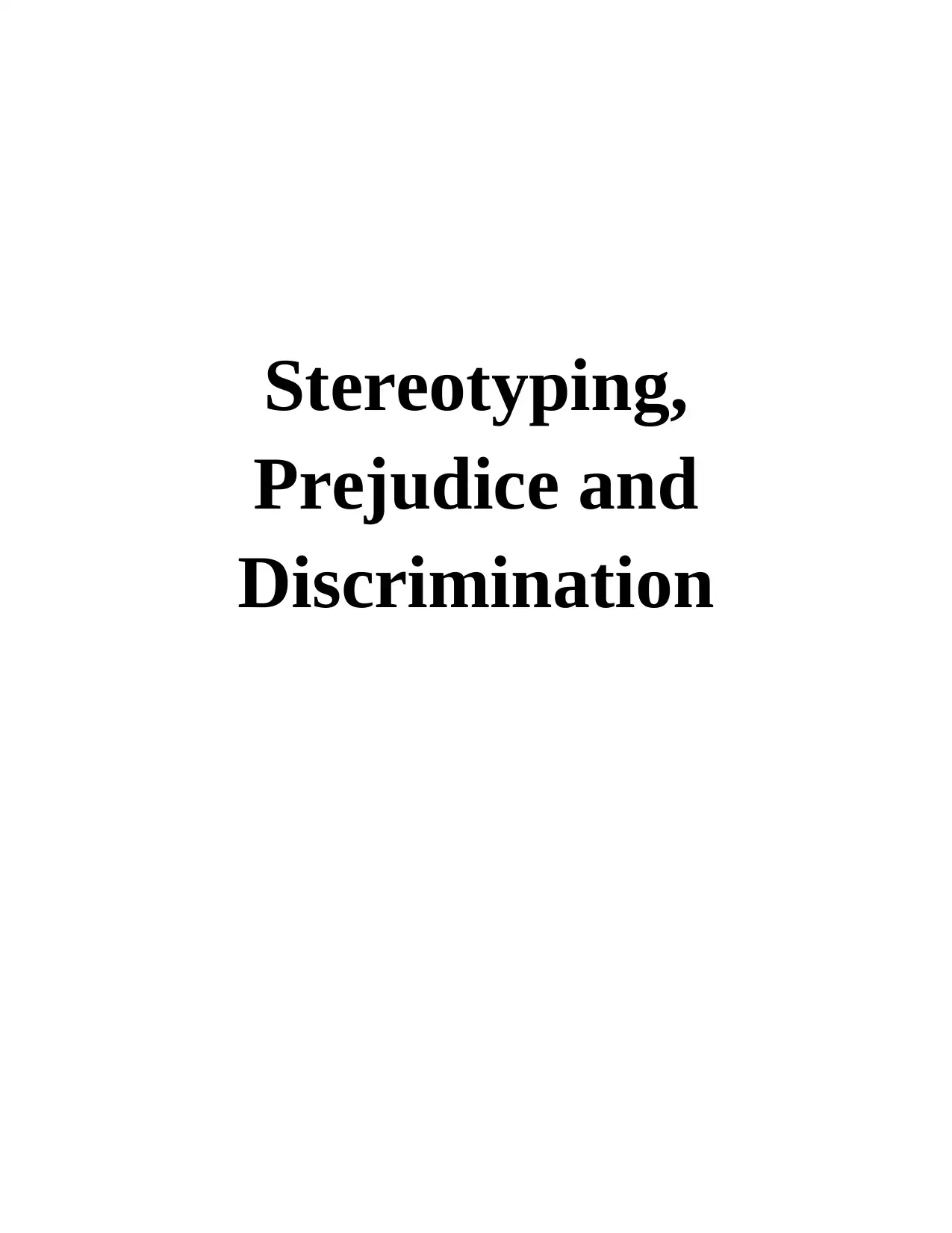
Stereotyping,
Prejudice and
Discrimination
Prejudice and
Discrimination
Paraphrase This Document
Need a fresh take? Get an instant paraphrase of this document with our AI Paraphraser
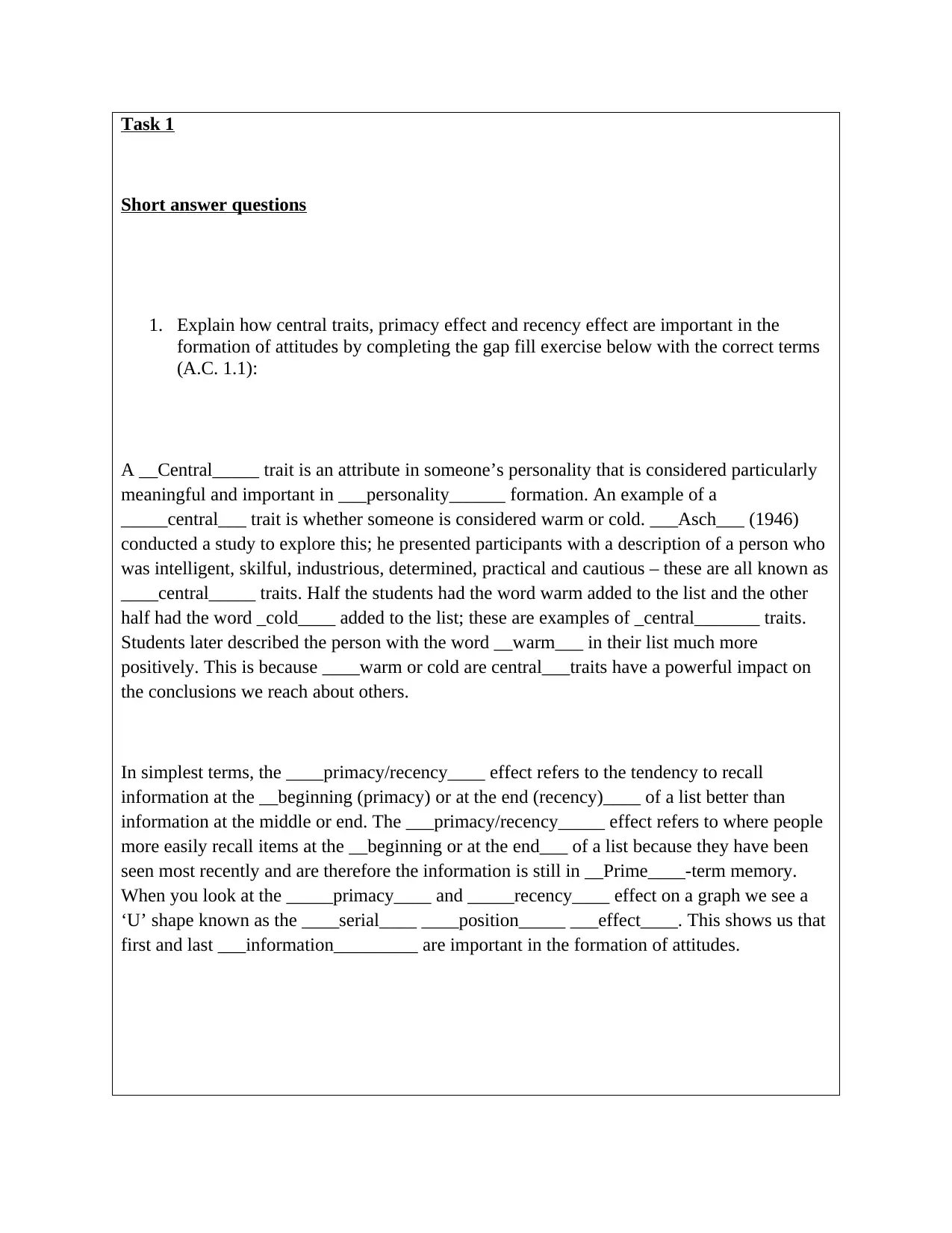
Task 1
Short answer questions
1. Explain how central traits, primacy effect and recency effect are important in the
formation of attitudes by completing the gap fill exercise below with the correct terms
(A.C. 1.1):
A __Central_____ trait is an attribute in someone’s personality that is considered particularly
meaningful and important in ___personality______ formation. An example of a
_____central___ trait is whether someone is considered warm or cold. ___Asch___ (1946)
conducted a study to explore this; he presented participants with a description of a person who
was intelligent, skilful, industrious, determined, practical and cautious – these are all known as
____central_____ traits. Half the students had the word warm added to the list and the other
half had the word _cold____ added to the list; these are examples of _central_______ traits.
Students later described the person with the word __warm___ in their list much more
positively. This is because ____warm or cold are central___traits have a powerful impact on
the conclusions we reach about others.
In simplest terms, the ____primacy/recency____ effect refers to the tendency to recall
information at the __beginning (primacy) or at the end (recency)____ of a list better than
information at the middle or end. The ___primacy/recency_____ effect refers to where people
more easily recall items at the __beginning or at the end___ of a list because they have been
seen most recently and are therefore the information is still in __Prime____-term memory.
When you look at the _____primacy____ and _____recency____ effect on a graph we see a
‘U’ shape known as the ____serial____ ____position_____ ___effect____. This shows us that
first and last ___information_________ are important in the formation of attitudes.
Short answer questions
1. Explain how central traits, primacy effect and recency effect are important in the
formation of attitudes by completing the gap fill exercise below with the correct terms
(A.C. 1.1):
A __Central_____ trait is an attribute in someone’s personality that is considered particularly
meaningful and important in ___personality______ formation. An example of a
_____central___ trait is whether someone is considered warm or cold. ___Asch___ (1946)
conducted a study to explore this; he presented participants with a description of a person who
was intelligent, skilful, industrious, determined, practical and cautious – these are all known as
____central_____ traits. Half the students had the word warm added to the list and the other
half had the word _cold____ added to the list; these are examples of _central_______ traits.
Students later described the person with the word __warm___ in their list much more
positively. This is because ____warm or cold are central___traits have a powerful impact on
the conclusions we reach about others.
In simplest terms, the ____primacy/recency____ effect refers to the tendency to recall
information at the __beginning (primacy) or at the end (recency)____ of a list better than
information at the middle or end. The ___primacy/recency_____ effect refers to where people
more easily recall items at the __beginning or at the end___ of a list because they have been
seen most recently and are therefore the information is still in __Prime____-term memory.
When you look at the _____primacy____ and _____recency____ effect on a graph we see a
‘U’ shape known as the ____serial____ ____position_____ ___effect____. This shows us that
first and last ___information_________ are important in the formation of attitudes.
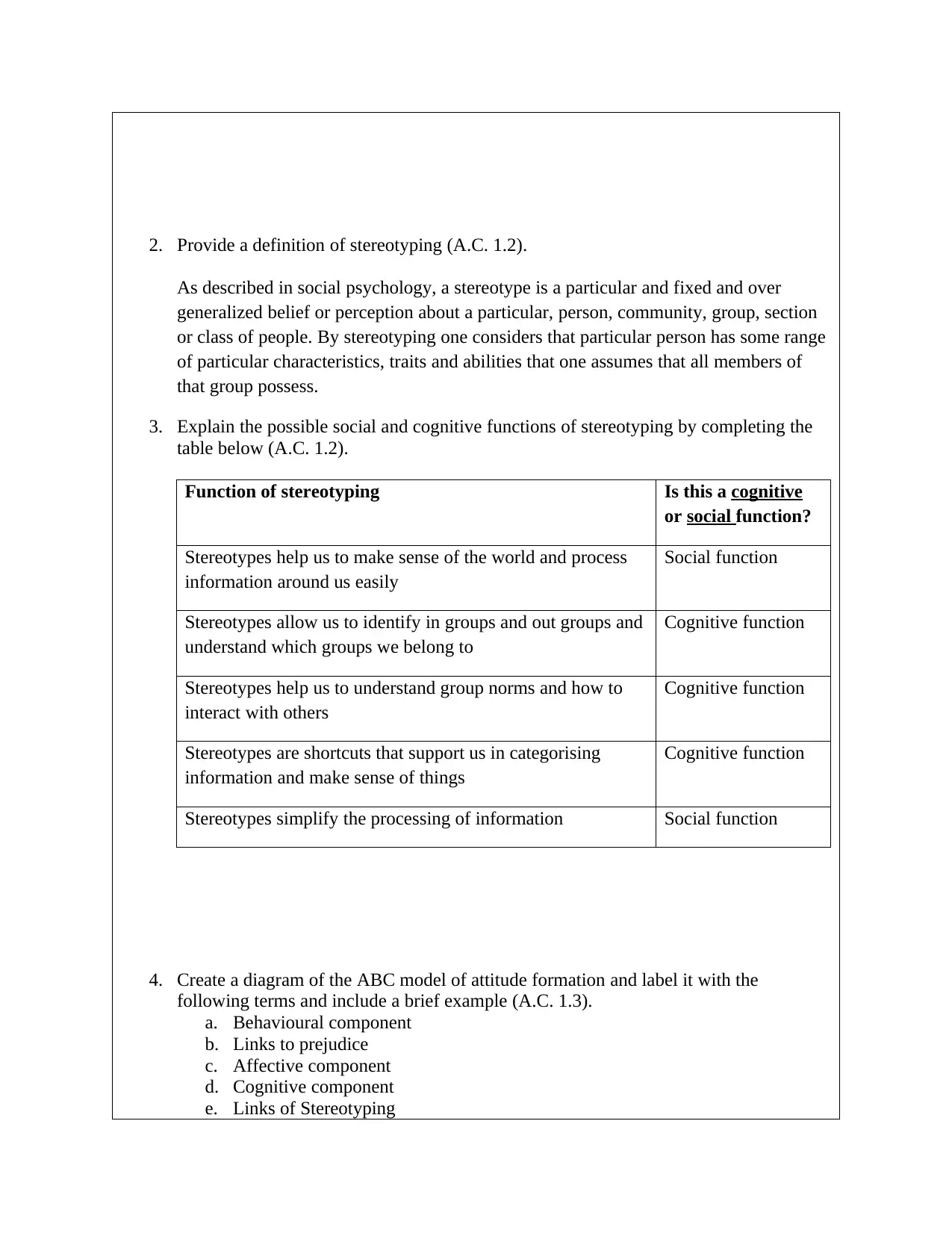
2. Provide a definition of stereotyping (A.C. 1.2).
As described in social psychology, a stereotype is a particular and fixed and over
generalized belief or perception about a particular, person, community, group, section
or class of people. By stereotyping one considers that particular person has some range
of particular characteristics, traits and abilities that one assumes that all members of
that group possess.
3. Explain the possible social and cognitive functions of stereotyping by completing the
table below (A.C. 1.2).
Function of stereotyping Is this a cognitive
or social function?
Stereotypes help us to make sense of the world and process
information around us easily
Social function
Stereotypes allow us to identify in groups and out groups and
understand which groups we belong to
Cognitive function
Stereotypes help us to understand group norms and how to
interact with others
Cognitive function
Stereotypes are shortcuts that support us in categorising
information and make sense of things
Cognitive function
Stereotypes simplify the processing of information Social function
4. Create a diagram of the ABC model of attitude formation and label it with the
following terms and include a brief example (A.C. 1.3).
a. Behavioural component
b. Links to prejudice
c. Affective component
d. Cognitive component
e. Links of Stereotyping
As described in social psychology, a stereotype is a particular and fixed and over
generalized belief or perception about a particular, person, community, group, section
or class of people. By stereotyping one considers that particular person has some range
of particular characteristics, traits and abilities that one assumes that all members of
that group possess.
3. Explain the possible social and cognitive functions of stereotyping by completing the
table below (A.C. 1.2).
Function of stereotyping Is this a cognitive
or social function?
Stereotypes help us to make sense of the world and process
information around us easily
Social function
Stereotypes allow us to identify in groups and out groups and
understand which groups we belong to
Cognitive function
Stereotypes help us to understand group norms and how to
interact with others
Cognitive function
Stereotypes are shortcuts that support us in categorising
information and make sense of things
Cognitive function
Stereotypes simplify the processing of information Social function
4. Create a diagram of the ABC model of attitude formation and label it with the
following terms and include a brief example (A.C. 1.3).
a. Behavioural component
b. Links to prejudice
c. Affective component
d. Cognitive component
e. Links of Stereotyping
⊘ This is a preview!⊘
Do you want full access?
Subscribe today to unlock all pages.

Trusted by 1+ million students worldwide
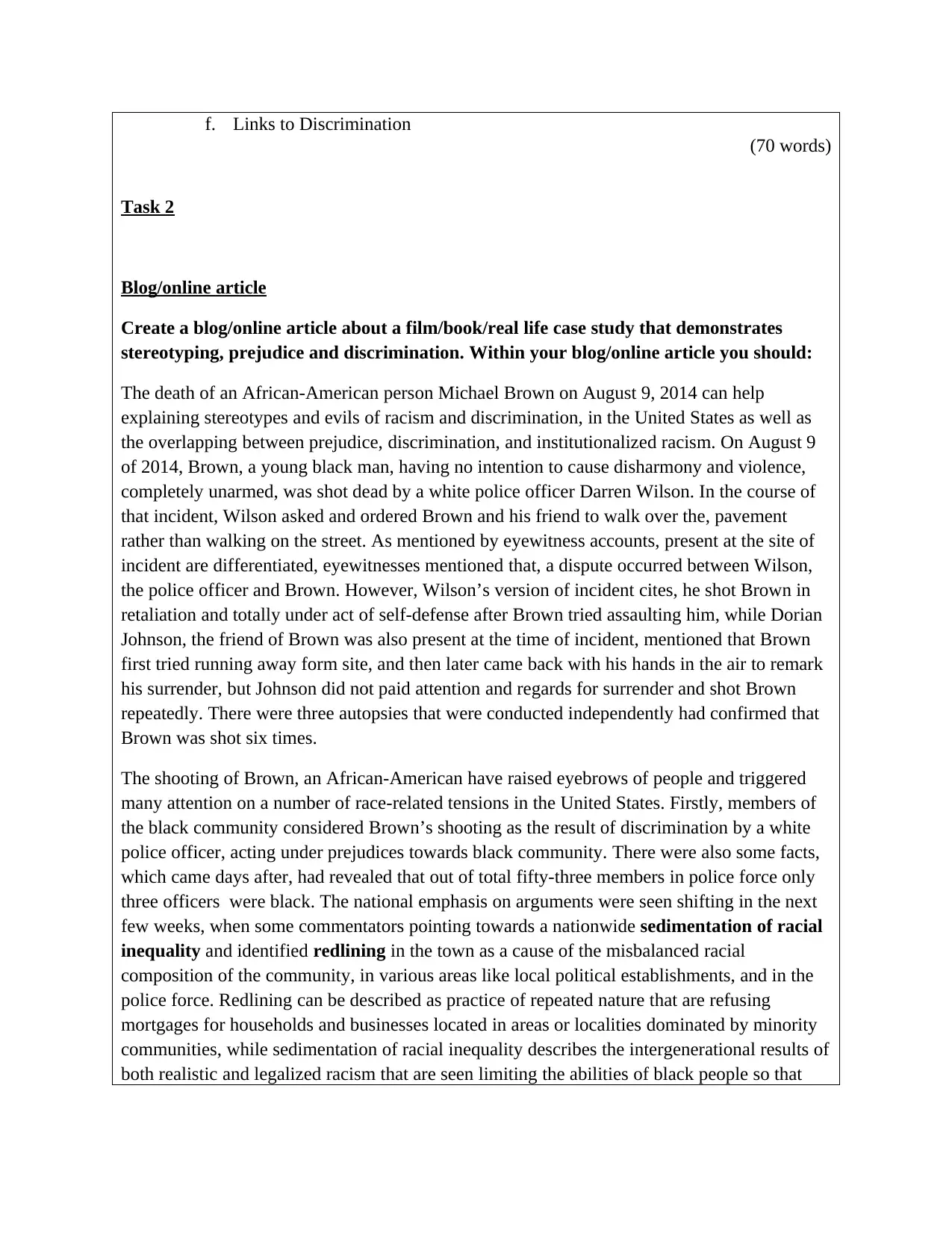
f. Links to Discrimination
(70 words)
Task 2
Blog/online article
Create a blog/online article about a film/book/real life case study that demonstrates
stereotyping, prejudice and discrimination. Within your blog/online article you should:
The death of an African-American person Michael Brown on August 9, 2014 can help
explaining stereotypes and evils of racism and discrimination, in the United States as well as
the overlapping between prejudice, discrimination, and institutionalized racism. On August 9
of 2014, Brown, a young black man, having no intention to cause disharmony and violence,
completely unarmed, was shot dead by a white police officer Darren Wilson. In the course of
that incident, Wilson asked and ordered Brown and his friend to walk over the, pavement
rather than walking on the street. As mentioned by eyewitness accounts, present at the site of
incident are differentiated, eyewitnesses mentioned that, a dispute occurred between Wilson,
the police officer and Brown. However, Wilson’s version of incident cites, he shot Brown in
retaliation and totally under act of self-defense after Brown tried assaulting him, while Dorian
Johnson, the friend of Brown was also present at the time of incident, mentioned that Brown
first tried running away form site, and then later came back with his hands in the air to remark
his surrender, but Johnson did not paid attention and regards for surrender and shot Brown
repeatedly. There were three autopsies that were conducted independently had confirmed that
Brown was shot six times.
The shooting of Brown, an African-American have raised eyebrows of people and triggered
many attention on a number of race-related tensions in the United States. Firstly, members of
the black community considered Brown’s shooting as the result of discrimination by a white
police officer, acting under prejudices towards black community. There were also some facts,
which came days after, had revealed that out of total fifty-three members in police force only
three officers were black. The national emphasis on arguments were seen shifting in the next
few weeks, when some commentators pointing towards a nationwide sedimentation of racial
inequality and identified redlining in the town as a cause of the misbalanced racial
composition of the community, in various areas like local political establishments, and in the
police force. Redlining can be described as practice of repeated nature that are refusing
mortgages for households and businesses located in areas or localities dominated by minority
communities, while sedimentation of racial inequality describes the intergenerational results of
both realistic and legalized racism that are seen limiting the abilities of black people so that
(70 words)
Task 2
Blog/online article
Create a blog/online article about a film/book/real life case study that demonstrates
stereotyping, prejudice and discrimination. Within your blog/online article you should:
The death of an African-American person Michael Brown on August 9, 2014 can help
explaining stereotypes and evils of racism and discrimination, in the United States as well as
the overlapping between prejudice, discrimination, and institutionalized racism. On August 9
of 2014, Brown, a young black man, having no intention to cause disharmony and violence,
completely unarmed, was shot dead by a white police officer Darren Wilson. In the course of
that incident, Wilson asked and ordered Brown and his friend to walk over the, pavement
rather than walking on the street. As mentioned by eyewitness accounts, present at the site of
incident are differentiated, eyewitnesses mentioned that, a dispute occurred between Wilson,
the police officer and Brown. However, Wilson’s version of incident cites, he shot Brown in
retaliation and totally under act of self-defense after Brown tried assaulting him, while Dorian
Johnson, the friend of Brown was also present at the time of incident, mentioned that Brown
first tried running away form site, and then later came back with his hands in the air to remark
his surrender, but Johnson did not paid attention and regards for surrender and shot Brown
repeatedly. There were three autopsies that were conducted independently had confirmed that
Brown was shot six times.
The shooting of Brown, an African-American have raised eyebrows of people and triggered
many attention on a number of race-related tensions in the United States. Firstly, members of
the black community considered Brown’s shooting as the result of discrimination by a white
police officer, acting under prejudices towards black community. There were also some facts,
which came days after, had revealed that out of total fifty-three members in police force only
three officers were black. The national emphasis on arguments were seen shifting in the next
few weeks, when some commentators pointing towards a nationwide sedimentation of racial
inequality and identified redlining in the town as a cause of the misbalanced racial
composition of the community, in various areas like local political establishments, and in the
police force. Redlining can be described as practice of repeated nature that are refusing
mortgages for households and businesses located in areas or localities dominated by minority
communities, while sedimentation of racial inequality describes the intergenerational results of
both realistic and legalized racism that are seen limiting the abilities of black people so that
Paraphrase This Document
Need a fresh take? Get an instant paraphrase of this document with our AI Paraphraser

they cannot accumulate wealth and resources, believed to be belonging to white people only.
Ferguson’s imbalance between races and different communities can help explaining and
providing validated reasons, that why even though in 2010 only about 63 percent of population
in town was black, whereas in 2013 black community people re being detained in 86 percent
of stoppages, 92 percent of searches, and 93 percent of arrests, this has highlighted that this
particular community is being deliberately criminalized, whose roots are in stereotypes against
black population. In addition, segregation in Ferguson’s schools has basis of wealth gaps,
urban sprawl, and unemployment rate in black community is three times compared to white
unemployment rate. These facts lays emphasis over worsened existing racial discriminations in
Ferguson and is also reflecting nationwide racial inequalities, becoming part of new normal in
society.
Task 3
Table
Outline and critically evaluate two theories of prejudice by completing the table below
(A.C. 2.2):
Theory Outline Evaluation/criticisms
Authoritaria
n personality
theory
Authoritarian
personality can be
described as a
personality of a person
who prefers social
system of strong ruling.
These type of people are
comfortable with a
strong ruler and attitude
of such people towards
that strong ruler is
demonstrative of strict
obedience and
adherence. In these
cases there is intolerance
towards non-
conservative and liberal
Critics consider this theory as ideologically
biased, in the construct of theory itself. Also,
there are criticism regarding F-scale measures
used to measure personality of a particular
person in the theory.
Ferguson’s imbalance between races and different communities can help explaining and
providing validated reasons, that why even though in 2010 only about 63 percent of population
in town was black, whereas in 2013 black community people re being detained in 86 percent
of stoppages, 92 percent of searches, and 93 percent of arrests, this has highlighted that this
particular community is being deliberately criminalized, whose roots are in stereotypes against
black population. In addition, segregation in Ferguson’s schools has basis of wealth gaps,
urban sprawl, and unemployment rate in black community is three times compared to white
unemployment rate. These facts lays emphasis over worsened existing racial discriminations in
Ferguson and is also reflecting nationwide racial inequalities, becoming part of new normal in
society.
Task 3
Table
Outline and critically evaluate two theories of prejudice by completing the table below
(A.C. 2.2):
Theory Outline Evaluation/criticisms
Authoritaria
n personality
theory
Authoritarian
personality can be
described as a
personality of a person
who prefers social
system of strong ruling.
These type of people are
comfortable with a
strong ruler and attitude
of such people towards
that strong ruler is
demonstrative of strict
obedience and
adherence. In these
cases there is intolerance
towards non-
conservative and liberal
Critics consider this theory as ideologically
biased, in the construct of theory itself. Also,
there are criticism regarding F-scale measures
used to measure personality of a particular
person in the theory.
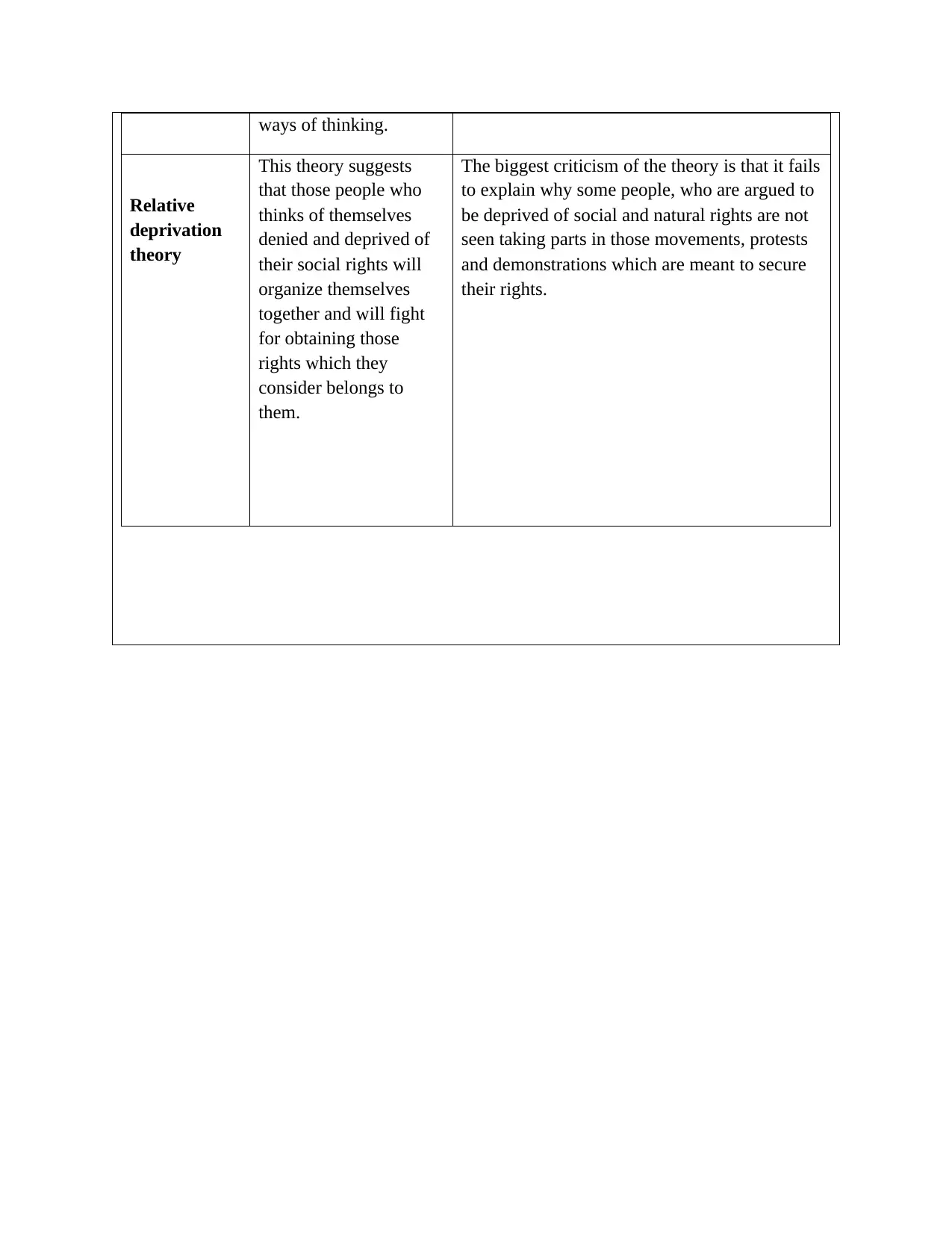
ways of thinking.
Relative
deprivation
theory
This theory suggests
that those people who
thinks of themselves
denied and deprived of
their social rights will
organize themselves
together and will fight
for obtaining those
rights which they
consider belongs to
them.
The biggest criticism of the theory is that it fails
to explain why some people, who are argued to
be deprived of social and natural rights are not
seen taking parts in those movements, protests
and demonstrations which are meant to secure
their rights.
Relative
deprivation
theory
This theory suggests
that those people who
thinks of themselves
denied and deprived of
their social rights will
organize themselves
together and will fight
for obtaining those
rights which they
consider belongs to
them.
The biggest criticism of the theory is that it fails
to explain why some people, who are argued to
be deprived of social and natural rights are not
seen taking parts in those movements, protests
and demonstrations which are meant to secure
their rights.
⊘ This is a preview!⊘
Do you want full access?
Subscribe today to unlock all pages.

Trusted by 1+ million students worldwide
1 out of 6
Your All-in-One AI-Powered Toolkit for Academic Success.
+13062052269
info@desklib.com
Available 24*7 on WhatsApp / Email
![[object Object]](/_next/static/media/star-bottom.7253800d.svg)
Unlock your academic potential
Copyright © 2020–2025 A2Z Services. All Rights Reserved. Developed and managed by ZUCOL.